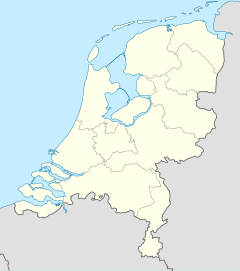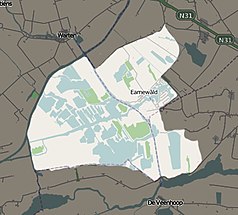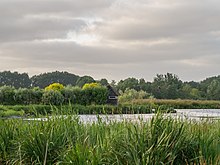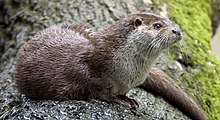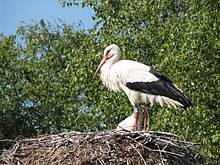De Alde Feanen National Park
| De Alde Feanen National Park | ||
|---|---|---|
|
|
||
| Location: | Friesland , Netherlands | |
| Next city: | Earnewâld | |
| Surface: | approx. 4,000 ha | |
| Founding: | 2006 | |
| Visitors: | 250,000 (2001) | |
| Address: | Koaidyk 8a NL-9264 TP Earnewâld |
|
| National park map | ||
The National Park De Alde Feanen ( West Frisian for: "the old Fenn "; Dutch National Park De Oude Venen ) is a national park in the Dutch province of Friesland . The national park, founded in 2006, offers a varied landscape with moors , heather areas and open water areas.
geography
The national park is located in the center of the province of Friesland and, with a size of around 4,000 hectares, is the largest contiguous nature area in the mainland part of the province. The municipalities of Leeuwarden , Smallingerland and Tytsjerksteradiel have a share in the area of the park. The small town of Earnewâld, about 12 kilometers southeast of Leeuwarden, is in the east of the national park and is completely enclosed by it.
In the middle of the national park is the so-called Princenhof , an area made up of several small lakes, bays and islands. The members of the House of Orange once used the Princenhof as a hunting ground. The Alde Feanen belong to a broad band of peat areas that stretches from Dokkum to Stavoren across the province of Friesland and is referred to in the Netherlands as " Friesland's Lage Midden ". Southwest of the park include, among others, the polder Islands De Burd and It Eilan , which, however, are no longer part of the park. The Jan Durkspolder is located in the south of Earnewâld .
The Alde Feanen form a varied wetland with lakes, bogs , floating mats , swamp forests and peatlands.
history
About 3,500 years ago peat began to form in the area below the Drentschen Plateau , to which today's Alde Feanen belong. This formation continued until the sea began to rise slowly and the area flooded several centuries before our era. During this period, a layer of peat about two meters thick was created, while large amounts of mud were also deposited in the west of the area . This created fertile clay soils , which attracted the inhabitants of the first terps in the region. From the 12th century onwards , the expansion of the Zuiderzee from the south-west posed a threat to the economically important peat bogs.
Peat extraction
Peat has been mined in the Frisian moors since the 12th century, but extensive exploitation did not begin until much later in the 16th century . A large number of canals were dug for the discharge of the cut peat towards the great cities of Holland . These activities first began in the area around the town of Heerenveen and increasingly spread to the east and north. Around Earnewâld, peat was only extracted to a large extent in the 18th and 19th centuries. This created elongated bodies of water about 1.5 meters deep, the so-called petgaten . Between these lay narrow strips of dry land that had not been excavated, on which the cut peat was laid out to dry, the so-called legakkers . Where these were removed by flooding, larger lakes formed through the merging of several narrow petgaten . The resulting landscape around Earnewâld was not suitable for poldering and is therefore still visible in this form today. After the peat extraction stopped around 1900, the current name of the area probably came up: de verlaten of oude vervening (for example: The abandoned or old Fenn ), which was derived from Oude Venen or Alde Feanen.
Around 1870 there were renewed plans to pold the area, but these failed because of the technical feasibility. In 1900 Earnewâld could only be reached with dry feet in summers with little precipitation. In 1920 there were renewed considerations regarding a piling up. At that time, however, arguments to keep the area in its previous form for nature conservation and recreation reasons were already predominant, which is why the plans were rejected again.
natural reserve
In 1923 the Vereniging Natuurmonumenten bought the first three hectares of land in the Alde Feanen. One of the first acquisitions of the It Fryske Gea nature conservation association, founded in 1930, was the Princenhof in 1934 , a wetland area of around 134 hectares in the center of the Alde Feanen. By 2001, the total area of the area owned by It Fryske Gea increased to 2,500 hectares.
Especially in the second half of the 20th century , serious pollution of the water and soil in today's national park was noted. The area is at the lowest point in the province of Friesland and suffers from the influx of contaminated water from the surrounding areas up to the IJsselmeer . In the 1990s, the flow of water into the area was stopped as far as possible and contaminated sludge was dredged. In addition, a number of new petgates have been dug and various areas have been "depolded".
The Alde Feanen have been designated as a bird sanctuary since 1992 and are part of the Ramsar Convention for the protection of important wetlands. In 1993, the Dutch Raad van State advocated the establishment of a nature reserve, provided that the preservation of the natural values of the Alde Feanen was laid down in a management plan. This plan was drawn up the following year by the province of Friesland and the municipalities of Tytsjerksteradiel, Boarnsterhim and Smallingerland in cooperation with the Ministry of Agriculture, Nature and Fisheries. Subsequently, examinations began as to whether the area could receive the status of a national park. In 1998 the responsible committee recommended the minister to set up such a park.
On February 16, 2000, the Alde Feanen were proclaimed a "National Park in planning". The reason for this was a discussion about the planned construction of a holiday park near Earnewâld. On April 26, 2006, the Alde Feanen were officially awarded the status of the twentieth national park in the European Netherlands by Cees Veerman , then Minister for Agriculture, Nature and Food Quality . Furthermore, in the same year, a large part of the national park area was designated as a Natura 2000 area. Today, De Alde Feanen National Park is mainly managed by It Fryske Gea.
flora
There are at least 450 different types of plants in De Alde Feanen National Park, including various sedge and orchids .
Natural silting is taking place in the area. The overgrowth of open water by plants stimulates processes that lead to the formation of solid land. From an ecological point of view, the intermediate stages of this process are particularly interesting, first and foremost the so-called vibrating lawn, a subsurface that looks like solid ground at first glance, but which is still undermined and "vibrates" with every step.
Another special form of vegetation are the so-called blauwgraslanden . Here is dominated mainly millet and hem sedge , marsh violets and Meadow knapweed . Other plant species that grow in this landscape are the English thistle , the marsh lice weed , the adder's tongue , the sundew or the marsh blood-eye .
Furthermore, there are some heather areas with the typical heather herbs and species such as the vaginal cottongrass , the round-leaved sundew or the lingonberry . In the transition areas there is also the gelatinous bush .
Large quantities of reeds grow along the water , which among other things provide a habitat for the endangered Nordic vole .
fauna
There are at least 35 different species of mammals in the Alde Feanen. Among these 35 species there are also four that have an entry on the Red List of Endangered Species : Pine marten , Nordic vole, water shrew and brown long-eared vole . The Nordic vole deserves special mention here, as it is otherwise only found in a few places.
otter
The otter lived in the area of today's national park until about the mid-1980s, before the population died out. Since the reintroduction of the species in the Overijssel Weerribben-Wieden National Park in 2002, the animals have been migrating again to the immediate vicinity of the Alde Feanen. In October 2011 a further six animals were released directly in the national park, three of which were orphaned young animals that had been found in the Rottige Meente nature reserve on the border with Overijssel the year before . The other specimens came from the Czech Republic and Austria .
Avifauna
There are 180 species of birds in the national park, around 100 of which also breed in the area. Some of the rarer species are, for example, the little grebe , the great reed warbler or the bearded tit , which is the national park's “mascot”. Access many other species that special protection status are the bittern , the purple heron , the marsh harrier , the Spotted Crake , the Baillon's Crake , the ruff , the black tern and common tern . In the Princenhof there is a breeding colony of cormorants with up to nine hundred nests.
Furthermore, the Alde Feanen are an important resting area for various bird species on their hikes . So regularly here Löffler , Bläss- and shelduck , wigeon and Gadwall , Alpine beach runner and godwits sighted. The wigeon in particular rest here in large numbers, around 2,500 individuals can be encountered at the same time in some years.
A rearing station for storks ( It Eibertshiem ) is located within today's national park. For some time now, the sea eagle has also returned to the Alde Feanen.
Others
Six species of amphibians and various freshwater fish live in the Alde Feanen . The insect populations in the national park have hardly been studied so far, but at least 22 species of dragonflies and 20 species of butterflies have been shown to live here . Among them are also rare species such as the early reed hunter , the wedge- spotted damsel and the brown-spotted mother-of-pearl butterfly .
tourism
In Earnewâld you will find the national park's visitor center called De Wiidpleats. The Frisian Agricultural Museum is located in the same place . The Alde Feanen are an important destination for tourists, in 2001 the annual number of visitors to the national park was estimated at 250,000 people. These ensure an annual turnover of around 11 million euros. The national park directly or indirectly creates jobs for around 200 employees.
literature
- Sietske Rintjema: De Alde Feanen . Friese Pers Boekerij / Verlag Noordboek, 2002, ISBN 90-330-1137-9 , p. 192 .
- Jan van de Kam: Spectrum Atlas van Beschermde Natural areas: Nederland & België . Verlag Het Spectrum, Utrecht / Antwerp 1984, ISBN 90-274-7408-7 , p. 240 .
- Half a Hettema: Gids Nationaal Park De Alde Feanen Guide . Friese Pers Boekerij, Leeuwarden 2009, ISBN 978-90-330-0834-4 , p. 144 .
Web links
Individual evidence
- ↑ The Frisian Lakes. In: enjoysailing.de. Retrieved July 23, 2018 .
- ↑ a b Location Midden. In: landschapsgeschiedenis.nl. Retrieved July 27, 2018 (Dutch).
- ↑ Divorce. In: np-aldefeanen.nl. Retrieved July 27, 2018 (Dutch).
- ↑ Met een bootje door oude veenmoerassen in Friesland. In: weflycheap.nl. Retrieved July 27, 2018 (Dutch).
- ↑ Altenburg, Wymenga: Natura 2000 beheer plan. (PDF) In: gemeentedocumenten.nl. Provincie Fryslan, November 2015, accessed July 27, 2018 (Dutch).
- ↑ Decree aanwijzing nationaal park Alde Feanen. In: overheid.nl. September 1, 2007, accessed July 27, 2018 (Dutch).
- ↑ Natura 2000 Alde Feanen. In: gemeentedocumenten.nl. Retrieved July 27, 2018 (Dutch).
- ↑ National Park De Alde Feanen. In: anwb.nl. Retrieved July 27, 2018 (Dutch).
- ↑ National Park De Alde Feanen. In: naturescanner.nl/. Retrieved July 27, 2018 (Dutch).
- ↑ National Park Alde Feanen. In: hollandgroen.nl. May 27, 2009, accessed July 27, 2018 (Dutch).
- ↑ Speciale beschermingszones voor de noordse woelmuis. (PDF) In: iquatro.org. Retrieved July 27, 2018 (Dutch).
- ↑ National Park De Alde Feanen. In: reisfanaten.be. Retrieved July 27, 2018 (Dutch).
- ↑ lijsten Rode: soort van Rode Lijst Zoogdieren. In: nederlandsesoorten.nl. Retrieved July 27, 2018 (Dutch).
- ↑ Otters vrijgelaten in the Alde Feanen. In: waldnet.nl. October 6, 2011, accessed July 27, 2018 (Dutch).
- ↑ Natura 2000-gebied Alde Feanen. (PDF) In: synbiosys.alterra.nl. Retrieved July 27, 2018 (Dutch).
- ↑ Everything about Earnewâld. In: frieslandwonderland.nl. Retrieved July 27, 2018 (Dutch).
- ↑ Twee jonge zeearenden! In: vogelbescherming.nl. June 25, 2018, Retrieved July 27, 2018 (Dutch).
- ↑ Sietske Rintjema: Alde Feanen . Friese Pers Boekerij, 2002, ISBN 90-330-1137-9 , pp. 13 .
